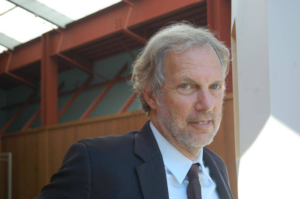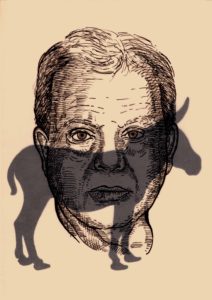De haardos van Lady Godiva
 Macbeth, Don Juan, Koningin Guinevere, Graaf Dracula, alle historische figuren hebben in meer of mindere mate – meestal mindere – een kern van waarheid, waarmee de geschiedenis naar eigen inzicht op de loop gegaan is.
Macbeth, Don Juan, Koningin Guinevere, Graaf Dracula, alle historische figuren hebben in meer of mindere mate – meestal mindere – een kern van waarheid, waarmee de geschiedenis naar eigen inzicht op de loop gegaan is.
Een interessant en pikant voorbeeld biedt Lady Godiva. De oerversie verhaalt hoe de Lady in kwestie gehuwd is met Leofric, graaf van Mercia in Midden-Engeland en de schatrijke maar rechtlijnige eigenaar van de stad Coventry en omstreken. Het is het jaar 1040. Lady Godiva heeft erg te doen met de bewoners, die zuchten onder de zware belastingen die de graaf hen oplegt en probeert haar man keer op keer te vermurwen.
Uiteindelijk toont hij zich bereid op haar smeekbeden in te gaan, op voorwaarde dat de Lady naakt op een paard gezeten door de stad rijdt. Zij accepteert zijn uitdaging en rijdt, slechts gehuld in haar lange haren, door Coventry. Op haar verzoek blijven alle bewoners binnen, met de luiken gesloten.
Die oerversie speelt in de eerste helft van de elfde eeuw, maar kreeg pas zo’n twee eeuwen later bredere bekendheid toen het verscheen in de Flores historiarum, een verzameling verhalen uit de Britse historie – letterlijk vertaald: Bloemen van de geschiedenis -, bijeengebracht door de benedictijner monnik Roger of Wendover. Het boek werd voor het eerst gedrukt in 1236.
De opofferingsbereidheid van Lady Godiva werd sindsdien op tal van manieren vormgegeven, met name in de beeldende kunsten – er zijn talloze schilderijen en beeldhouwwerken van gemaakt – en in literatuur: toneelstukken, gedichten, prozastukken. Echt grote populariteit kreeg het thema pas in 1842, toen het gedicht Godiva van Alfred, Lord Tennyson (1809-1892) in druk verscheen.
Van ander werk waarin zij een hoofdrol speelt, valt het toneelstuk Monna Vanna (1902) op, van de Franstalige Belg Maurice Maeterlinck (1862-1949), aan wie in 1911 de Nobelprijs voor literatuur werd toegekend. Het thema van ‘Wedden dat’ krijgt hier vorm in het verhaal over de schone Monna Vanna, echtgenote van Guido Colonna. De stad Pisa is omsingeld door het leger van Florence, de bevolking wordt uitgehongerd. Als tegenprestatie voor het beëindigen van de belegering eist Prinzivalle, de leider van de Florentijnen, dat (Gio)vanna één nacht bij hem doorbrengt, slechts gekleed in een mantel. Guido voelt zich door deze eis in zijn mannelijke eer aangetast, maar Vanna aarzelt geen moment. En terecht, want Prinzivalle gedraagt zich als een heer en volstaat met een kus op haar voorhoofd.
Uiteraard leende zo’n prikkelend gegeven zich bij uitstek voor verfilming. Er zijn dan ook ettelijke films gemaakt met een titel als Lady Godiva rides, maar die hebben allemaal niet veel meer om het lijf dan een verhaallijntje rondom die ene gewaagde scene. De Engelse productie Lady Godiva rides again (1951), bijvoorbeeld, werd in Amerika uitgebracht onder de titel Bikini Beach. Dat zegt al genoeg.
De mythe van Lady Godiva heeft overigens nog een begrip in de Engelse taal opgeleverd. Terwijl alle burgers van Coventry zich aan haar verzoek hielden om niet te pogen een glimp van de naakte amazone op te vangen, kon één man de verleiding niet weerstaan. Tom the Taylor kijkt stiekem toch en wordt daarvoor met blindheid gestraft. Sindsdien is Peeping Tom of, voluit, Peeping Tom of Coventry – to peep is gluren – de gangbare Engelse term voor voyeur. Er is overigens weinig grond om aan te nemen dat het nieuwsgierig kleermakertje echt bestaan heeft.
In 1960 werd de Britse film Peeping Tom uitgebracht, over een seriemoordenaar die zijn slachtoffers filmt terwijl hij ze ombrengt. De Duitse hartenbreker Karlheinz Böhm speelt daarin de titelrol.
Ook in de Nederlandse letteren heeft de Lady zich gemanifesteerd, al was het dan ook slechts in het titelgedicht van de bundel Lady Godiva op scooter van Sybren Polet uit 1960. Polet – een pseudoniem van Sybe Minnema (1924-2015) – wordt in vakkringen gerekend tot de Experimentelen en de Vijftigers, maar door literatuurliefhebbers ook wel tot de Onleesbaren. Een willekeurig fragment uit het onderhavige werk moge ter illustratie volstaan:
Rijd, rijd zo dicht langs hen heen
dat de politieagenten gedichten gaan schrijven
die ze des avonds met gemotoriseerde stem
aan hun vrouwen voorlezen
en de direkteur van de Universiteitsbibliotheek, geprikkeld,
zijn hoed afneemt
om zich de literatuur van het voorhoofd te wissen.
Ook de rest van het gedicht heeft niets met Lady Godiva te maken.
Dat interessant en pikant nog steeds een bruikbare combinatie vormen, blijkt uit de pop-artiesten die het thema in een nummer verwerkten. Dat zijn niet de minsten. Neem The Velvet Underground, de groep rond Lou Reed en John Cale. Die hadden zich al voor Venus in furs op hun debuutalbum The Velvet Underground & Nico uit 1967 literair laten inspireren door de novelle Venus im Pelz (1870) van de Oostenrijkse auteur Leopold von Sacher-Masoch, aan wiens naam en werk het begrip masochisme is ontleend.
Op het daarop volgende album, White light/White heat (1968), staat het nummer Lady Godiva’s Operation, met tekst en muziek van Lou Reed. Tot de meer verrassende interpretaties van de operatie in kwestie, hoort die volgens welke het hier een geslachtsverandering zou betreffen. De regels
Doctor arrives with knife and baggage
Sees the growth as just so much cabbage
That now must be cut away
zouden verwijzen naar een woekering – the growth – die verwijderd moet worden. Het vervolg vult daarop aan, dat er niet alleen aan weerszijden geopereerd wordt, maar ook dat de ingreep onomkeerbaar is:
Now come the moment of great great decision
The doctor is making his first incision
One goes here, one goes there
De Britse formatie Simply Red, bekend van de hit Holding back the years, bracht in 1987 het album Men and women uit, met daarop Lady Godivas’s room.
Ook het damestrio Boney M, meestal voorzien van een éénmansballet, stortte zich op Lady Godiva.
Dat werd met enige argwaan tegemoet gezien, aangezien hun historisch besef niet overdreven betrouwbaar was gebleken. In het refrein van hun wereldhit Rasputin gingen zij immers voorbij aan het feit dat Rusland geen koningin had maar een tsarina:
Ra Ra Rasputin
Lover of the Russian queen
Om in het geval van Lady Godiva het zekere voor het onzekere te nemen, kozen ze als tekst ongeveer de korte versie van een hoofdstuk uit een geschiedenisboek:
Her name was Lady Godiva
A lady so brave and so strong
Her husband the Earl of Mercia
He treated her terribly wrong
She’s a lady
She’s a lady
She rode naked on horseback
To stop him from his tax increase
(..)
Then sneaking a glance through the window
Was a guy they called Peeping Tom
He caught a glimpse and was blinded
Curiosity sometimes is wrong
Het meest blijft de dappere daad van de Lady in ons geheugen hangen door de hit die het Engelse duo Peter & Gordon er mee scoorden, een nummer dat overigens in Coventry niet te horen mocht zijn omdat de burgemeester de tekst obsceen achtte. De volledigheid vereist hier te vermelden dat die tekst niet zozeer over Her Ladyship ging als wel over een lokale stripteaseuse (Seventeen, a beauty queen) die, gezegend met lang haar en niet door gêne geremd, carrière maakt in Hollywood, zij het in films van bedenkelijk allooi.
Voor een vergelijking met de echte Lady Godiva hadden Peter & Gordon niet meer dan een paar regels nodig:
Her long blond hair
falling down across her arms
hiding all the lady’s charms
In november 1966 staat Lady Godiva op de zesde plaats in de Amerikaanse Top-100.



